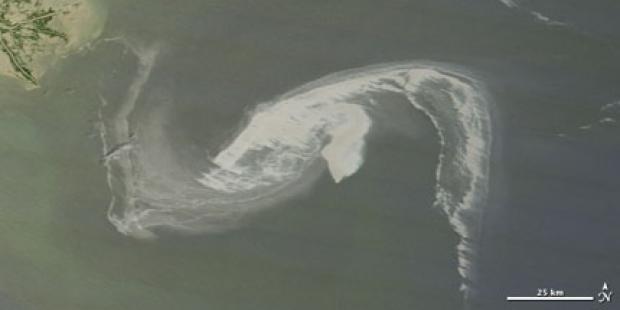Gulf of Mexico oil slick: the view from space © NASA
The Gulf of Mexico is in the news right now, because of a catastrophic oil spill. You will probably already have seen the pictures. We’ve already pointed out that this is yet another example of the impact our global dependency on oil is having, and how BP in particular, are at fault for their relentless pursuit of the black stuff. They’ll seemingly stop at nothing to fill up oil barrels.
The images we most associate with oil spills are of the impact on wildlife: sea otters in Prince William Sound , or seabirds in Shetland, covered with oil. It’s a dramatic and easily understood impact on our seas’ biodiversity.
So it’s little wonder that the impacts on the marine wildlife in the Gulf of Mexico are now being given a lot of thought. And the warm seas of the Gulf, source of the stream of water that keeps the west of the UK that bit warmer than it should be, are full of species people care about. Turtles, whales, dolphins, manatees and seabirds are all at risk. The risks for species that make it to land, are easier to appreciate. Oil-slicked beaches are hardly a suitable nesting place for a turtle, and oil-covered seabirds are clearly doomed. But for the species that rarely break the surface the risks are less easy to see.
The impacts on fish and other species may be less visible, but no less real. And the effects will last, too, as contaminants wipe out food sources, or work their way up the food chain.
Included in the oil spill’s hit-list is the current poster-fish of the oceans, the Atlantic bluefin tuna.
In the UK we associate bluefin more with the Mediterranean, but this species spans the Atlantic . In fact the Gulf of Mexico is crucially important to Atlantic bluefin. Like the area around the Balearic Islands in the Mediterranean, these fish gather to breed in the warm waters of the gulf. These are the vital nursery grounds for the species. And right now is spawning time. It couldn’t have happened at a worse time. Greenpeace has argued for years that protected areas at sea are necessary, and for bluefin, protecting their spawning grounds is a no-brainer. I mean if we had a breeding ground on land for endangered species like rhinos, tigers or gorillas, of course we’d protect it, right? And even for those keen to keep commercially exploiting the species, protecting the breeding grounds makes obvious sense.
But one thing the oil spill shows is that just stopping fishing in such an area isn’t enough. The man-made problems affecting our oceans all add up. In the Gulf of Mexico the overfished population of Atlantic bluefin have just been dealt a huge blow from the oil spill. For a population already on the brink of extinction, this is the last thing it needed. We need to create protected areas, but we need to protect them effectively if they are to work. That means all destructive activity needs to be banned. But it also means we need to properly control activities elsewhere, that could impact on the areas and species we must protect.
Let’s face it, if we can’t handle and control oil spills in the Gulf of Mexico, we’ve sod all chance of doing it somewhere less accessible and even more vulnerable like the Arctic.
I wonder how far we need to go in destroying species and ecosystems before we’ll say enough is enough?




